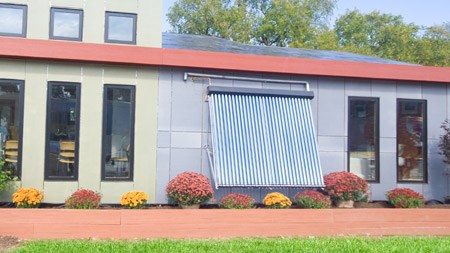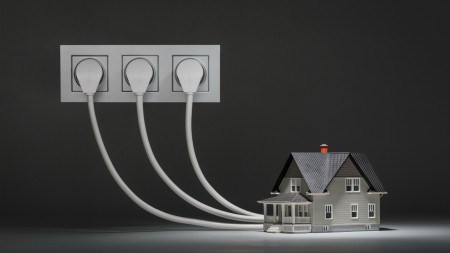With talk of man living on Mars, under water, or as is already the case, on huge new man-made islands, how will our residences adapt to the environmental needs and challenges of the future?
Already, Britain is looking to build amphibious homes in areas subject to high flood risk, with one such luxury house constructed on an island in the River Thames, specially designed in order to rise or fall according to fluctuating water levels.
One thing is certain - homes will need to adapt to our changing requirements and climatic and socio-economic requirements, says Louise Varga, project manager for Pam Golding Properties in the Boland and Overberg regions. Partnered with the Green Building Council of South Africa (GBCSA), Pam Golding Properties is actively driving a better understanding of value in the residential property market with regard to a home’s green credentials.
New green certification programme
In helping empower the residential property market to design and build resource-efficient buildings, GBCSA has implemented a new green building certification programme called EDGE (Excellence in Design for Greater Efficiencies). Available via a free online software platform, this simple, user-friendly green rating tool aims to achieve a minimum saving of 20 percent in energy, water and embodied energy in materials. Smart, fast and affordable, it calculates the upfront cost and potential operational savings of green buildings.
Says Varga: “As South Africa is becoming ever more environmentally conscious, the urge to protect the environment and reduce one’s carbon footprint has expanded into the world of architecture and construction, making energy-efficient design of ever-increasing relevance.
“Environmentally conscious solutions to design and construction that have been widely adopted in this country include factors such as waste product reduction, efficient use of energy and land, alternative renewable power solutions – for example, solar, minimal environmental habitat disruption, water conservation, use of local and natural materials, recycling of materials and intelligent design.
“A shift can be seen in contemporary architecture to consciously reduce the consumption of energy, carbon emissions and so on, while what is referred to as ‘passive’ design considers energy saving solutions in terms of the building’s location, orientation, glazing area and insulation. Each of these elements works with others to create a greener, more comfortable home environment which can also take into account seasonal change.”
Phillippe Fouché, a director of SAOTA says the relationship between buildings and the environment is as old as architecture itself. “Great buildings have always responded to the landscape, the environment and the climate in which they are sited. The great buildings of the future will continue that relationship.
“By their very nature buildings are long-term and should therefore be forward-looking in their conception, and so ‘future proofing’ can massively enhance their long-term sustainability. It’s an oft repeated statistic that buildings generate an astonishing one out of every three tonnes of carbon dioxide emissions. Hence architects, designers and builders have a key role to play in providing a sustainable future in our cities and landscapes.
Sustainable development
“In recent years architects have taken advantage of many exciting developments in sustainable construction. Some of these developments take the form of expensive technologies but in general sustainability in architecture can be traced back to ‘first principles’ that can be seen in great buildings throughout history and should always be at the heart of the design process - from the humblest renovation to the construction of entire cities.
“A key principle in the early stages of the design process falls broadly under the heading of ‘orientation’. This encompasses not only how a building or a space is oriented or positioned on a site but how the path of the sun is responded to through the seasons, how shading and glazing mitigate its impact and the degree to which visual connections to the landscape are enhanced. Simple moves – such as using generous overhangs to provide shade during the summer while allowing low winter sun to penetrate deep into the plan, and an analysis of prevailing winds and the provision for cross ventilation can radically improve the thermal comfort of a space. Choosing locally sourced, recycled or reused materials can dramatically reduce a building’s carbon footprint.”
Fouché says all too often ignored, the precious commodity that is water will also play a key role in defining future designs. Again relatively simple steps can be taken to ensure that water is harvested efficiently and reused where possible, irrigation systems can be designed to use grey water recycling and the choice of sanitary fixtures can massively reduce water consumption.
“Often overlooked, the importance of building management systems will become more widely recognised. Again there are many expensive and complex systems used to monitor and manage everything from energy usage to waste control. But relatively straightforward decisions – designing sensible lighting circuits, exploiting the climatic conditions with ‘thermal mass’ and providing transparency within a building - can, respectively, dramatically reduce electricity wastage, prevent constant climatic changing and reduce the artificial lighting requirements.”
What the experts have to say
Carol Reynolds, Pam Golding Properties area principal for Durban Coastal, says more and more people are looking at sustainable residential developments. “A global network has been developed around the concept of eco-villages and this is indeed the way of the future. Communities of like-minded people are living together in self-sufficient eco-estates with boreholes, solar heating and solar and wind-generated power, and water tanks and underground systems to conserve the environment.
“From a design perspective we are seeing a shift away from big double-storey blocks to modular homes with different levels, cantilevered platforms and the use of wood, glass and steel. The general look is one of simple, understated elegance that complements the environment, while homes are now seen as an integral component of their surrounds rather than separate from it.”
Adds Laurie Wener, title for Pam Golding Properties in the Western Cape: “Realistically we need to have smaller and more manageable low-maintenance homes which conserve energy, reduce utility costs and are close to good public transport. For example homes of modular design and construction, where required modules can be selected, transported to the site and fixed to pre-laid foundations with minimum of time and no wastage or mess. Self-cleaning, labour-saving devices will be of primary importance while provision for the recharging of electrically operated vehicles may become the norm.”
Within Baronetcy Estate in Cape Town’s burgeoning Northern Suburbs, home owners are prioritising energy efficient homes or even going completely off-grid, according to Pierre Nel, area principal for Pam Golding Properties Plattekloof.
“Load shedding prompted many home owners to install powered battery systems that work off solar panels, and run all the necessary, lights, ADSL lines, telephones, TV and small appliances. On this estate, most homes have solar geysers or heat pumps to further enhance energy efficiency, while some include electric swimming pool covers to reduce water evaporation.
“Some two years ago the South African National Standard 01400-XA regulation for energy efficiency was implemented with all new homes in the country required to comply. Baronetcy Estate homes are already designed to these specifications, for example – most windows need to be double glazed or incorporate a special tint which ensures that the home is cool in the summer and warm in the winter by regulating the temperature within the home, thereby reducing energy usage for air conditioning or heating. There is much taken into account when the properties are designed, including window size, wall cavities and orientation or positioning of the home. With ever-increasing electricity and water tariffs, fully off-grid homes are becoming more and more appealing for residents on the estate.”
Adds Stefan Antoni, a director of SAOTA: “One of our projects in Russia involved extensive solar studies to maximize the three months of summer sunshine and any available sun thereafter, and in the desert outside Dakar we designed a totally sustainable camp in a forest of Baobabs. Few architectural firms get to work on such diverse, exiting projects.”





